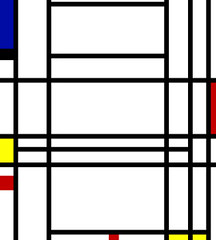 This week's reading, "Illustrated magazine and the photographic revolution," outlines the historic evolution of graphic design as both an art medium and a journalistic tool.
This week's reading, "Illustrated magazine and the photographic revolution," outlines the historic evolution of graphic design as both an art medium and a journalistic tool.The article discusses a number of major developments and trends throughout the evolution of graphic design, but none so impactful or enduring as the grid. As designers, we have been taught to utilize grids for three key purposes:
- streamline and organize content
- assist readers in comprehension of the story
- keep layouts consistent from issue to issue The grid from "Tron: Legacy"
Interestingly enough, the article reveals that the origin behind the initial use of the grid was inspired by a graphic storyboard. The illustration was used to "associate disparate elements in both space and time." This directive relationship used to keep story lines intact became universality recognized as the most significant organizational requirement expected of formatted magazines. I find this expectation to be very appropriate while considering the role grids play when it comes journalism: to organize a story and help readers understand it.
The following excerpt from the article explains the grid's significance to both design and journalism.
 "The magazine is a continuum of cover, contents page, minor features, major features and miscellany, with a specific architectural integrity which, in this respect, differs from other forms of printed matter. This is why the grid takes on a double function in the magazine. The underlying geometric framework suggested by the work of the synthetic cubists and rather more directly by the compositional studies of Mondrian and can Doesburg, could be utilized as an anchor of constancy, or point of reference, with unrestrained asymmetric layouts."
"The magazine is a continuum of cover, contents page, minor features, major features and miscellany, with a specific architectural integrity which, in this respect, differs from other forms of printed matter. This is why the grid takes on a double function in the magazine. The underlying geometric framework suggested by the work of the synthetic cubists and rather more directly by the compositional studies of Mondrian and can Doesburg, could be utilized as an anchor of constancy, or point of reference, with unrestrained asymmetric layouts."Piet Mondrian's "Composition 10" (1939–1942) inspired the use of the grid in graphic design.
In the end, what I've taken away from this reading as a whole is that graphic design as we know it didn't just begin thriving as technology progressed. To fully appreciate it as both an art medium and as a journalistic tool, we need to understand its historical significance as well as how it has evolved over time.

What I love about this post is that it reminds me of one of the reasons why I love designing. The grid offers a sense of stability and order -- even when our designs are whimsical and offbeat. My parents always told me never understood why I wanted to go into journalism when I had such a strong aptitude for math. And this blog reminded me of my response: designing is like a math problem, all the pieces are the numbers and the final layout is the equation that gave me the answer.
ReplyDelete